Albania, North Macedonia, Kosovo, and Serbia
- adventouring
- Sep 7, 2023
- 11 min read
Updated: Sep 11, 2023
After another seamless and quick border crossing, we found ourselves in Albania. The journey into the city of Shkodër was a little chaotic due to the traffic, afternoon heat, and an audacious little girl who managed to rev Brian’s throttle while asking for money, but we eventually made it to our hotel. After cooling off in the air conditioning, we took to the streets to explore the downtown. Despite the impending rain, there were quite a few people out and it felt as if every middle-aged man decided to go for a bicycle ride at the same time.




As the rain clouds started to roll in, we popped into the Marubi National Museum of Photography. The museum provided a unique insight into Albanian history, culture, and customs from the 1860s to the mid-1900s. It was fascinating to look at the photos and imagine what daily life was like for these individuals.


The following morning we rode into the mountains to Theth, a remote village in the Accursed Mountains (aka Albanian Alps). The most famous day-hike in Albania is a trail that connects Theth to the even more remote village of Valbona via a beautiful mountain pass. Most people spend a day on each end of the hike just getting to and from the trail, hiking it as a point to point. We, however, decided to ride the bikes to Theth and see if we could do the pass as an out and back to save some time and effort. We made our way along the scenic winding mountain road into town.




After checking into our guesthouse, we had lunch and spent the afternoon planning and relaxing. We made friends with some of the other guests and enjoyed a communal home-cooked meal together (courtesy of our host), chatting well into the evening. I wish we had taken photos of the delicious food and our new friends that night (or either of the two nights that followed), but it was nice to set our phones aside and just enjoy the present moment.




We awoke early the next morning to begin making our way up the pass. The first half of the hike was a steep ascent through a lush green forest. As we emerged from the tree line, we were greeted with gorgeous views of the surrounding sunlit peaks.


We had the trail mostly to ourselves until we reached the top of the pass and crossed paths with the hikers coming from the Valbona side. We spent over an hour at the top watching the clouds roll over the peaks of the mountains and into the valley below before beginning the steep descent back into town.






On our way out of town earlier in the morning, we met two other young riders on dual sport motorcycles. Given that the majority of riders we typically meet are older men, we were excited to see a younger couple with another female rider! We made plans to meet up with Sabrina and Hannes that evening, so after another lovely communal meal at our guesthouse we took some beers over to their campsite. It was so nice to share stories and get to know them. They were on a multi-week trip through the Balkans, predominantly on dirt, and as it turned out they were planning to ride a nearby off-road route that Brian was itching to do. The route is part of something called the TET, which stands for Trans Euro Trail, and it is a series of mostly dirt tracks through 35 countries in Europe. This particular section of the Albanian TET is notoriously difficult (above my skill level), so Brian was considering doing it alone. It was serendipitous that we met Sabrina and Hannes, and the following morning the three of them set off on the route (with Brian borrowing my lighter and more off-road capable bike).





I opted to go for a hike to a nearby waterfall and then had a relaxing afternoon. Brian returned late in the evening having completed the route with no damage to himself or the bike and with a couple of good stories.

The following morning we set off for Tirana, the capital of Albania. The stark contrast between the remote mountains and the bustling city became all the more evident as we made our way through rush hour traffic. Once the afternoon heat began to subside with the setting sun, we explored the city on foot. Tirana is a very lively city known for its colorful Ottoman-, Italian -, and Soviet-era architecture. We walked through the heart of the city, Skanderbeg Square, admiring the giant statue of the national hero of Albania which the square is named after, before making our way to an area with a buzzing nightlife scene. We moseyed our way into a place called Radio Bar where we found an awesome vibe and some delicious drinks featuring the local liquor, Rakia. They even had my all-time favorite from our South America days - pisco sour!










We spent the next two days relaxing, doing some bike maintenance, and visiting various museums including the National History Museum, the Museum of Secret Surveillance, and a former Cold War bunker turned contemporary art and history museum. Bunkers are a ubiquitous sight in Albania. In fact, there are anywhere between 175,000 - 750,000 bunkers (depending on whom you ask) across the country that were built between the 1960s and 1980s by Albanian dictator Enver Hoxha, stemming from his paranoia of an invasion from the Soviet Union, Yugoslavia, and NATO. They ultimately were never used for their intended purposes, but we came across quite a few of them as we rode through the Albanian countryside.





After leaving Tirana, we headed toward the southern coastal city of Ksamil. Despite riding up in elevation over the Llogara Pass, this was our hottest day yet as the temperature reached 104 degrees Fahrenheit! We often found ourselves in slow-moving traffic as we passed through the coastal towns, and we stopped frequently to drink water and rest in the shade. It was a long day of riding, but we were rewarded with a gorgeous sunset over the Adriatic.


The next morning Brian rode to Butrint National Park, a UNESCO World Heritage site with well-preserved ruins from the Roman Empire, the Middle Ages, and the Venetian era.


I decided to have a low-key morning and then go for a long walk to explore the town and search for a free beach. The latter part proved harder than expected as most of the Albanian Riviera is jam-packed with beach chairs and umbrellas for hire at ridiculous prices (20 euros for one chair!). Before coming, we had read that the Albanian Riviera is less developed and more rugged, but mass tourism has definitely caught up in recent years and this “undiscovered gem” is rather popular in August.


In order to avoid paying for a beach chair, we opted to pack one of our waterproof duffles and swim 100 meters to the nearest island. We weren’t the only ones with this idea, but we were able to find a small slice of seclusion on the island and went for short swims in the choppy but refreshing water.





The next day we left the coast and headed up the SH75, riding almost half the length of the country on what would become our favorite day of paved riding in Albania. The roads were empty compared to the coast with sweeping turns and varied terrain. A small afternoon shower helped to cool down the temperature making it even more enjoyable.


After a 10-hour day of riding, we crossed the border into North Macedonia just as the sun was setting over Lake Ohrid, one of the oldest and deepest lakes in the world.


When we arrived in the town of Ohrid we were instantly introduced to Macedonian hospitality by our friendly hotel owner who offered us a drink and insisted on helping to carry our heavy bags up to the room. This was just the first example of many to come as we found Macedonians to be exceedingly friendly and welcoming throughout our entire time in the country.
The next day was spent exploring Ohrid and our first stop was a coffee shop right on the lake with this fantastic view.



After getting our caffeine fix, we walked around the picturesque old town. Encircled with medieval walls, dotted with beautiful churches and mosques, and nestled between the mountains and the turquoise waters of the lake, Ohrid is truly breathtaking.










And unlike many of the areas we had recently been, Ohrid has yet to be overrun by tourism. Brian and I were pleasantly surprised to find free beach chairs lining the shores. After grabbing some lunch, we quickly changed into our bathing suits and headed for the water. The temperature was perfect and the scenery idyllic as we stayed to watch the last rays of sun dance across the water.






After having some of the best pizza we had eaten since Italy, we stumbled upon a folklore festival with people performing traditional dances from various countries. It was fun to watch and provided the perfect ending to one of my favorite non-riding days.


The next day we visited the National Workshop for Handmade Paper where we saw a replica of the Gutenberg Press and learned how it worked.

We then walked up to the fortress and admired the views of the city and the lake from above.




For lunch, we found a restaurant that happened to be owned by one of the founding members of the Ohrid Motorcycle Club. It was so nice chatting with Neim and he insisted we take two free Ohrid Motorcycle Club t-shirts - yet another example of Macedonian hospitality.

After watching people on paddle boards the previous day, we decided to rent some of our own and set out to explore the lake after lunch. Our balance was put to the test by the waves of the passing boats, but it was a fun way to explore the coastline and we enjoyed yet another gorgeous sunset over the water.



The following day we took the bikes out to explore the surrounding roads. We took a fantastic twisty and traffic-free route through Galicica National Park and Pelister National Park. We then decided to try riding a portion of the Macedonian TET. We made it a few miles in on very challenging terrain before meeting some friendly ATV riders who warned us of the huge loose boulders and difficult route ahead so we decided to turn around. The road was a bit more type two fun for me, but it was a great learning experience.






We left Ohrid the next day en route to the capital of North Macedonia - Skopje. We passed through the charming town of Vevchani, stopped to admire the Bigorski Monastery, rode some amazing canyon roads, and made friends with two Swiss riders.





We spent the next three days in Skopje running errands (including getting a new rear tire and drive chain for Brian’s bike), exploring the old bazaar (the second largest in the world), admiring the almost comical number of large statues all over the city, trying some insanely delicious Macedonian food, and eating at our new favorite burger joint multiple times.









We had heard about a popular and beautiful canyon nearby called the Matka Canyon, so on our way out of the city we decided to make a detour to check it out. When we got stopped by two confused looking men dressed in camouflage at a fence we started to wonder if we were going the right way. After utilizing the translation app on our phones to explain to them that we were just trying to get to the canyon they told us we could pass if we didn’t take any photos for the next nine kilometers. We agreed, a little befuddled, and pressed on. As it turns out, the canyon we made it to was indeed the Matka Canyon, but we had navigated to a rarely visited section of it and apparently through a monitored section of land. It ended up being one of the best mistakes we made because the roads were incredibly fun and we had them entirely to ourselves. The popular section of the canyon, which we did eventually make it to, was a complete tourist trap so it was a happy accident indeed.



After a quick lunch, we pressed on until we reached the border of Kosovo. The crossing went smoothly and we took the scenic route through some beautiful country roads into the city of Prizren.






Prizren is often called the most beautiful city in Kosovo and based on the number of photos we took we are inclined to agree. We spent the following day walking up to the fortress and exploring the old town.











The next morning we left Prizren and rode south through Sharr Mountains National Park in search of some off-road riding. All of the roads ended up being paved, but were still great fun to ride.

After riding north for a while and getting lunch in the town of Gjakova, we made a stop at the Meja Massacre Memorial; a memorial for the 376 victims of the mass killings nearby during the Kosovo War in 1999.


Since we didn’t find any off-road in the morning, we decided to try a section of the Kosovo TET near the town of Junik, but it quickly became a little too difficult with all of our luggage and the huge construction trucks on the narrow road so we turned around. Our next stop was the Monastery Visoki Decani, a UNESCO World Heritage site and one of the best-preserved examples of Romanesque architecture with Byzantine artistic influences. It is currently functioning as a monastery with 20 Serbian Orthodox monks. Interestingly, the monastery is guarded by KFOR, a NATO-led international peacekeeping force in Kosovo, and you have to hand over your passport and go through a military checkpoint to visit.
Since tensions are still high between ethnic Albanians (who are predominantly Muslim) and Serbs (who are predominantly Orthodox Christian), this is probably a good point to bring up some of the recent history that dominated headlines in ‘98 and ‘99 to provide some context. While 85% of Kosovo’s population had been ethnic Albanians before the Kosovo War, Kosovo was still under the control of Serbia, which considers Kosovo its historic capital. Attempts by Kosovo for additional independence and autonomy boiled over into armed conflict between the Serbian military and the Kosovo Liberation Army in ‘98 which led to ethnic cleansing. After NATO intervened in the conflict on the side of the ethnic Albanians, Kosovo achieved its independence and is now recognized by 119 countries, although Serbia is definitely not one of them. (Side note: There's a lot more to this complex conflict and this short summary is quite reductive, but important to give context to our time in this region).



After visiting the monastery, we rode to the town of Peja and enjoyed an evening of people-watching in the lively downtown area.

The next morning we rode the bikes into the gorgeous Rugova Canyon.




We didn’t ride too far, however, because this day we had two border crossings to make. Since Serbia does not recognize Kosovo as a country, the US State Department website advises people to avoid crossing directly into Serbia from Kosovo (unless you have already entered Serbia first). Thus, we exited Kosovo into Montenegro so we could enter Serbia from a recognized border. At the border, we met a man in the car behind us named Derek Chappell. After chatting with him, we learned he was a spokesperson for KFOR and NATO in the ‘90s (wild!) and he had some really fascinating stories and perspectives to share.
We spent a short hour in Montenegro before heading to the Serbia border. The border official performed the most thorough examination of our paperwork yet and at one point he closed the window to call over and speak with one of his colleagues about our documents (we thought he was about to give us a hard time about our Kosovo stamps), but we eventually made it into Serbia without issue!
The Serbian countryside was full of beautiful winding roads, which made for some amazing riding. At one point during the ride, Brian spotted a Florida license plate. We immediately turned around to chat with the owner as we had seen almost no American plates the entire trip thus far. It turned out to be owned by a super friendly Serbian man whose brother lives in Jacksonville, FL. We spent a while chatting with him and his family and even got invited to their barbecue that evening. Unfortunately, we had to press on (although we both wish we could have stayed).
Given everything we had learned about Serbia in the recent conflicts throughout the Balkans, this encounter and all of the ones to come were great reminders that people are not their politicians.



We continued riding through the countryside (which reminded us of the vast landscapes of Wyoming) before arriving at our guesthouse on a bend of the Uvac River. We enjoyed a lovely home-cooked meal from our host while overlooking the river.






The next day took us through the forests of Tara National Park and along the Drina River on our way to Belgrade, the capital of Serbia. It was a long 365-kilometer day, but the roads were incredible. During the last hour of riding it started to downpour and we arrived at our hotel in the city soaking wet.







We spent the next three days in Belgrade route planning, running errands, visiting multiple museums (the National History Museum, the Military Museum, the Nikola Tesla Museum, and the Museum of Yugoslavia), and going on a free walking tour of the city.







I also spent a lot of time catching up on the blog, and I am finally all caught up as I write this sentence in this beautiful cafe.

Tomorrow, we will head into the land of Dracula - Romania!
Cheers,
Brian and Erin



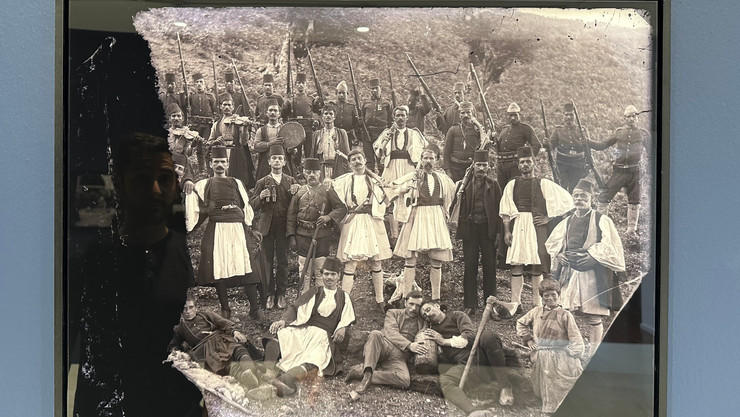





























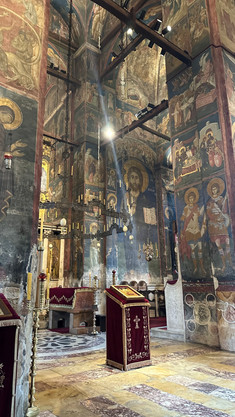



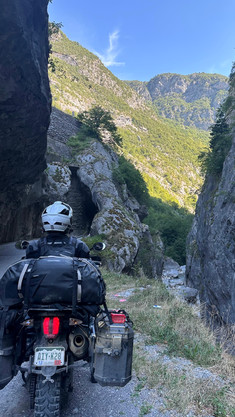



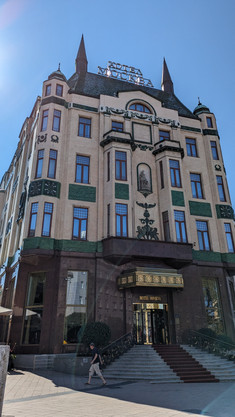









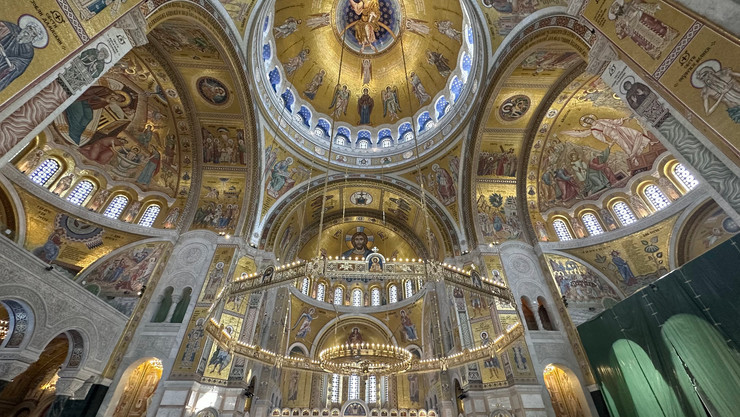









Comentários